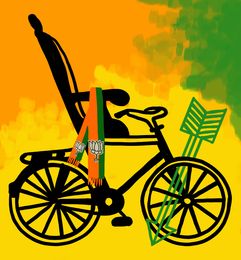The Narendra Modi government has a wafer-thin majority. Either of Modi’s partners, the JD(U) with 12 seats or the TDP with 16, can upset the apple cart. That was the condition of V.P. Singh’s government. It lasted 11 months. That too was the condition of Atal Bihari Vajpayee’s first government in 1996. That lasted 13 days. The plug can be pulled at any time.
In such circumstances, it is hardly surprising that Modi is offering a “consensual” government. Implicitly, this acknowledges that his previous governments were authoritarian and built around a personality cult. Both defining characteristics were integral to Modi’s personality and political past. They are also the defining characteristics of the hindutva ideology he espouses. How then, short of a lobotomy, can his protestations of running a third government opposite to his previous two be taken seriously?
First, what becomes of hindutva? Shaheen Bagh has triumphed. The Preamble to the Constitution, symbol of the Muslim women’s protest, has won. “Love jihad”, “land jihad”, now even “vote jihad” thrown out of the window. No to “bulldozer” politics. No more lynching for votes; no more riots for votes; no more genocide for votes. No more demanding that secularists “go to Pakistan” (and, in my case, “take your daughters with you!”) No more appeasement of the majority. No more vote banking by demonising religious minorities. Dog whistling and innuendo out. Hate speech denounced. Hate actions even more so. What then remains of hindutva?
On the very eve of its centenary, hindutva has been stopped in its tracks. After 10 years of power-drunk majoritarianism, will Nagpur accept that the Ram Mandir is all that remains of hindutva? Will the saffron cadre acknowledge that the dismantling of democratic institutions has to stop? That the weaponisation of governance agencies can no longer be fostered? Will they quiescently accept being shorn of their wolf’s clothing?
Will the electorate further tolerate a fawning judiciary denying the principle of “bail, not jail” that has made “the process the punishment” and converted Kashmir into “an open prison”? And a complaisant Election Commission? The voter cannot hold the courts or EC to account; so, will he/she turn on the government?
Nitish Kumar and Chandrababu Naidu are not offering their indispensable support for free. They know—and Modi knows—that one tantrum and it is curtains for Modi 3.0. Theirs is a case of ‘Dil maange more’. Does Modi have the wherewithal to meet their incessant demands?
The capture of mainstream media by favoured barons has already led to viewers drifting away, and even media celebrities have. We are in the age of podcasts and YouTubers. They can’t be taken over by moneybags. They are a standing monument to fear denied. Freedom of expression has been reaffirmed. Can Modi reverse that?
And what of Modi himself? The truth is now out: Modi is a biological being. He is no instrument of divinity, as he imagines himself. His attempt to combine the roles of the prime minister and the chief priest has been mocked. His claim to being the sole source of every welfare scheme and every government initiative has been laughed out of court. His mugshot on every hoarding, every poster, every ad, every document, even Covid inoculation certificates, has been seen for what it is: narcissism and megalomania. His making this election a popularity contest on himself has been punctured. He is alone in asking, “Mirror, mirror on the wall/tell me who is fairest of them all.” Can Modi so drastically transmogrify himself? Only a psychiatrist can tell.
Which is why I foresee only two years at most for the next Lok Sabha election.
Aiyar is a former Union minister and social commentator.


